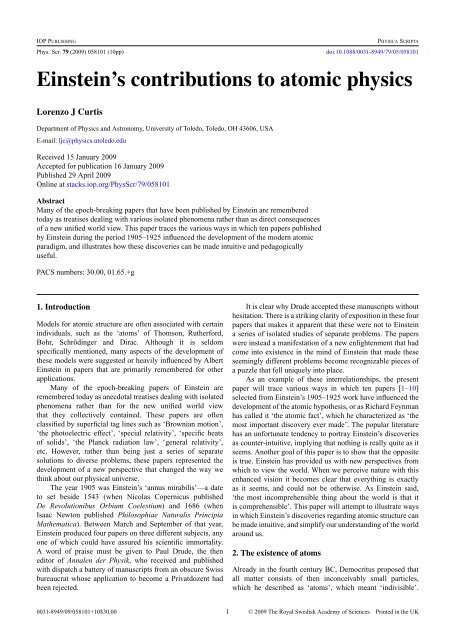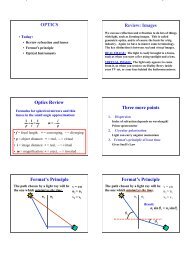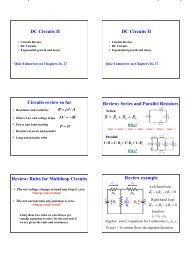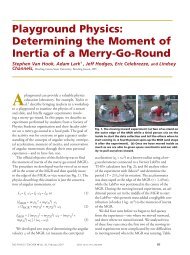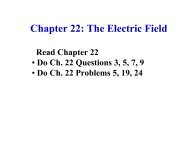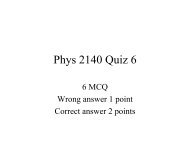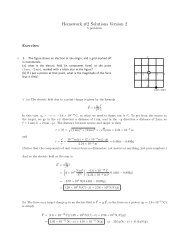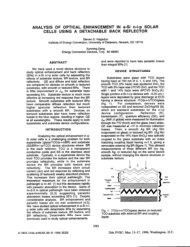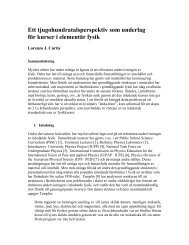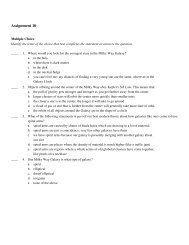Einstein's contributions to atomic physics - Department of Physics ...
Einstein's contributions to atomic physics - Department of Physics ...
Einstein's contributions to atomic physics - Department of Physics ...
Create successful ePaper yourself
Turn your PDF publications into a flip-book with our unique Google optimized e-Paper software.
Phys. Scr. 79 (2009) 058101Bohr assumed the unrealizably special case <strong>of</strong> an exactlycircular orbit, which allowed him <strong>to</strong> limit consideration <strong>to</strong>the azimuthal action integral. Assuming this <strong>to</strong> be an integermultiple <strong>of</strong> Planck’s constantn φ¯h = 12π∮p φ (φ) dφ, (3)he obtained the familiar expression for the Balmer energy.Arnold Sommerfeld and William Wilson later extendedthis treatment relativistically <strong>to</strong> include elliptic orbits,assuming the quantizationsn θ ¯h = 12π∮p θ (θ) dθ; n r ¯h = 12π∮p r (r) dr. (4)This formulation is known as the Bohr–Sommerfeld–Wilson(BSW) quantization. It quickly leads <strong>to</strong> results that conflictwith experiment, and it is routinely dismissed in most modern<strong>physics</strong> textbooks. However, the origin <strong>of</strong> these errors is notin the general approach, but in a simple mathematical mistakemade in its application. If correctly formulated, this actionquantization can be very useful and provides many valuableresults.While the azimuthal quantization made by Bohr is proper,the zenith and radial quantizations are incorrect, as was shownby Einstein in 1917 [9]. In this paper, Einstein pointed outthat the con<strong>to</strong>ur integral for the r and θ coordinates donot involve rotations, but rather librations, which oscillatebetween two turning points (caustics). In such cases theintegral involves a con<strong>to</strong>ur over two Riemannian sheets, whichleads <strong>to</strong> a phase jump at each turning point. The problemwas subsequently studied by Léon Brillouin, Joseph B Kellerand Vik<strong>to</strong>r Pavlovich Maslov, and the quantization can becorrectly stated as [16](n i + (µ i /4))¯h = 12π∮p i (q i ) dq i . (5)Here, µ is the Maslov index, which corresponds <strong>to</strong> the number<strong>of</strong> turning points. Thus µ = 0 for rotations, µ = 1 for motionswith a single turning point (such as field emission from a coldcathode or the tip <strong>of</strong> a scanning tunneling microscope), µ = 2for librations between two turning points and µ = 4 for aninfinite square well (which has two turning points and tworeflections).This formalism is known as the EBK quantization. Ityields correct values for most <strong>of</strong> the standard problems <strong>of</strong>quantum mechanics, and has advantages over fully quantummechanical treatments in a number <strong>of</strong> applications. Theprocedure is not only applicable <strong>to</strong> a<strong>to</strong>mic <strong>physics</strong>, but isalso the basis for the computation <strong>of</strong> the RKR (for RagnarRydberg, Oskar Klein and Albert Lloyd George Rees) methodfor computing the Franck–Condon fac<strong>to</strong>rs in molecular<strong>physics</strong>.For spherically symmetric potentials, the angular actionintegrals can be performed. In terms <strong>of</strong> the modernquantum mechanical notation m l ≡ ±n φ and l ≡ n θ + n φ ,these quantizations yield, for the orbital angular momentumL and its z-projection L z ,L = (l + (1/2))¯h; L z = m l¯h. (6)L J CurtisThis is in agreement with the modern quantum mechanicalresult for L z , and L 2 = (l 2 + l + (1/4))¯h 2 approaches thequantum mechanical result l(l + 1)¯h 2 in the correspondencelimit. For the Coulomb and isotropic harmonic oscilla<strong>to</strong>rpotentials, the EBK radial quantization yields the same energylevels as modern quantum mechanical calculations.In this little-known paper [9, 17], Einstein corrected anerror in the formulation <strong>of</strong> the BSW quantization, generalizedthe method <strong>to</strong> problems with several degrees <strong>of</strong> freedom thatare not separable and also addressed a pr<strong>of</strong>ound questionregarding classical and quantum chaos. In 1887 the King<strong>of</strong> Sweden had sponsored as a contest a challenge <strong>to</strong>show rigorously that the solar system is stable. The Frenchmathematician, astronomer and physicist Henri Poincarésubmitted an entry, which at first appeared <strong>to</strong> have succeeded,but Poincaré subsequently discovered an error. Poincaré’scorrection <strong>of</strong> that error is generally regarded as the birth <strong>of</strong>chaos theory. In Einstein’s 1917 paper, he pointed out that themethod (later called EBK) fails if there do not exist a number<strong>of</strong> integrals <strong>of</strong> motion equal <strong>to</strong> the number <strong>of</strong> degrees <strong>of</strong>freedom, that is, unless the system is integrable. He suggestedthat the non-integrable case is typical <strong>of</strong> classical dynamics,but indicated that the quantum situation was an open question.While this aspect <strong>of</strong> the paper was ignored until the 1960s, theproblem noted by Einstein is fundamental and has never fullybeen overcome.It is unfortunate that this very important and conceptuallyfertile paper by Einstein has been almost completelyoverlooked by textbook writers (although not by researchers).5. Relativity and fine structureThe titular subject <strong>of</strong> the June paper <strong>of</strong> Einstein’sannus mirabilis is seldom mentioned in discussions <strong>of</strong> itsimplications. The title <strong>of</strong> the paper is ‘On the electrodynamics<strong>of</strong> moving bodies’ [3] and its first sentence states ‘It is knownthat Maxwell’s electrodynamics—as usually unders<strong>to</strong>od atthe present time—when applied <strong>to</strong> moving bodies, leads<strong>to</strong> asymmetries which do not appear <strong>to</strong> be inherent in thephenomena’. While this paper is usually referred <strong>to</strong> by thetag line ‘special relativity’, its intent was not <strong>to</strong> describerocket ships traveling at velocities near the speed <strong>of</strong> light,but rather <strong>to</strong> describe magnetic fields produced by currentscorresponding <strong>to</strong> electron drift speeds <strong>of</strong> tens <strong>of</strong> millimetersper second or less [15]. Thus the results <strong>of</strong> this paper shouldappear in every elementary <strong>physics</strong> textbook between thechapters on Coulomb’s law and the Biot–Savart law, butinstead it is deferred <strong>to</strong> the end <strong>of</strong> the book or saved for asubsequent advanced course for <strong>physics</strong> majors.The beauty and simplicity <strong>of</strong> the relativistic formulationcan be seen from the following pedagogic example [16].Consider a copper wire 1 mm in diameter through whicha current <strong>of</strong> 1 A passes. Assuming one conduction electronper copper a<strong>to</strong>m, this current corresponds <strong>to</strong> a drift speed <strong>of</strong>110 mm s−1 .One <strong>of</strong> the results <strong>of</strong> special relativity is the fact thatif two extended objects move relative <strong>to</strong> each other, eachunderestimates the length <strong>of</strong> the other along the direction <strong>of</strong>motion. Thus, <strong>to</strong> an observer who is stationary relative <strong>to</strong> thewire, the negative electron charge will appear slightly denser.4
Phys. Scr. 79 (2009) 058101Figure 1. Model for a current.This is a very small effect, but it is greatly enhanced as seen bya charge that moves with a significantly larger speed relative<strong>to</strong> the wire. A model for such a current is shown in figure 1.If a segment <strong>of</strong> the wire <strong>of</strong> length L 0 contains a positivecharge Q and a free-electron charge −Q with a drift speed u,and the test charge q has a speed ±V (either parallel orantiparallel <strong>to</strong> the electron drift) at a distance r from the center<strong>of</strong> the wire, the Coulomb force on the test charge is given byF = 2K qr[QL 0√1 − (V2/c 2 )Q− √L 0 1 − ((±V − u)2 /c 2 )]. (7)Here, we have included the apparent relativistic contraction <strong>of</strong>the two line charges as seen by the moving test charge. Thiscan be binomial expanded <strong>to</strong> yieldF ≈ 2K qr[(Q1 + V 2 )L 0 2c + · · · 2To first order in u/c this becomes−(1 + V 2 ∓ 2V u + u 2 )]+ · · · . (8)2c 2(2K qVF ≈ ± − Qu ). (9)rc 2 L 0Although u is small, Q/L 0 is large, and their product can beidentified as the current in the wire. Thus we can defineI ≡ −Qu/L 0 ; B ≡ 2(K/c 2 )I/r; F = ±qV B, (10)where the plus sign denotes repulsion if the test charge movesin the same direction as the electron drift, and the minussign denotes attraction if the test charge moves opposite <strong>to</strong>the electron drift. This simple model demonstrates that theBiot–Savart law is a consequence <strong>of</strong> Coulomb’s law andrelativity, and not a separate experimental fact.While this paper is probably the one considered the mostradical by the general public, the basic concepts <strong>of</strong> relativityhad been in the scientific air for a very long time. Alreadyin 1887, Woldemar Voigt [18] had studied transformations<strong>of</strong> the electromagnetic wave equation between space-timecoordinate systems for which the wave speed is invariant,and obtained the equations that are <strong>to</strong>day called the Lorentztransformations. Thus Voigt conceived the idea <strong>of</strong> a universalvalue for the speed <strong>of</strong> light and demonstrated that the Dopplershift in frequency is incompatible with New<strong>to</strong>nian absoluteL J Curtistime. In 1895 the transformations were rederived in anothercontext by George FitzGerald and Hendrik An<strong>to</strong>on Lorentz.Although the Lorentz and Voigt corresponded frequently, the1887 paper by Voigt had escaped the attention <strong>of</strong> Lorentz,who belatedly cited the work <strong>of</strong> Voigt in the 1908 edition<strong>of</strong> his book The Theory <strong>of</strong> Electrons. Prior <strong>to</strong> Einstein’spresentation, Henri Poincaré presented a lecture on the‘Principle <strong>of</strong> Relativity’ at the 1904 St. Louis World’s Fair(the scene depicted in the 1940s Hollywood musical ‘MeetMe in St. Louis’). However, the clarity, thoroughness andtransparency <strong>of</strong> Einstein’s presentation brought all <strong>of</strong> thevarious aspects <strong>of</strong> relativity <strong>to</strong>gether in a manner that certainlyjustifies his priority.There are many features <strong>of</strong> relativity that influenced thedevelopment <strong>of</strong> a<strong>to</strong>mic theory. One involves the relativistickinetic energy T , which can be written in terms <strong>of</strong> the mass mand momentum p asT = √ (mc 2 ) 2 + (pc) 2 − mc 2[∼= mc 2 1 + 1 ( p) 2 1( p) 4− + · · ·]− mc 2 . (11)2 mc 8 mcIn terms <strong>of</strong> the nonrelativistic kinetic energy T 0 ≡ p 2 /2m, thisbecomesT ∼ = T 0 − ( T 20 /2mc2) + · · · , (12)and the correction E <strong>to</strong> the nonrelativistic energy is〈E〉 = 〈T 〉 − 〈T 0 〉 = 〈T 20 〉/2mc2 . (13)(The angular brackets indicate orbital averages.) For aCoulomb potential, the <strong>to</strong>tal nonrelativistic energy E 0 = T 0 −(κ/r) (here and henceforth κ ≡ e 2 /4πɛ 0 ), so〈T 20 〉 = 〈(E 0 + (κ/r)) 2 〉 = E 2 0 + 2E 0〈κ/r〉 + 〈κ 2 /r 2 〉 (14)and the virial theorem yields E 0 = −〈κ/r〉/2; hence〈E〉 = − κ22mc 2 [〈r −2 〉 − 3 4 〈r −1 〉 2 ]. (15)In terms <strong>of</strong> the semimajor axis a and semiminor axis b <strong>of</strong> theelliptic orbit, this is[〈E〉 = − κ2 12mc 2 ab − 3 ], (16)4a 2where a 0 is the Bohr radius. This is the expression for theenergy correction <strong>to</strong> the advance <strong>of</strong> the perihelion <strong>of</strong> theplanet Mercury as predicted by Einstein on the basis <strong>of</strong> specialrelativity (7.2 arcseconds century −1 ). The EBK quantizationfor the hydrogen a<strong>to</strong>m yields the valuesa = a 0 n 2 ; b = a 0 n(l + (1/2)). (17)Inserting these values yields the correct quantum mechanicalexpression for the relativistic momentum fine structurecorrection[〈E〉 = − Rα2n 31(l +12]) − 3 , (18)4nwhere R = κ/2a 0 and α = √ κ/mc 2 a 0 are the Rydberg andfine structure constants.5
Phys. Scr. 79 (2009) 058101L J CurtisIn most modern <strong>physics</strong> textbooks, the treatment <strong>of</strong> The corresponding expression obtained by applyingelectron in the hydrogen a<strong>to</strong>m, but obtained results that〈E〉 = Rα 2 〈L · S〉n 3 (l + (1/2)) . (24) disagreed with experiment. This disappointment caused him3 <strong>to</strong> abandon the work for several months. However, heEinstein’s calculation <strong>of</strong> the advance <strong>of</strong> the perihelion <strong>of</strong>Mercury and the calculation <strong>of</strong> the fine structure <strong>of</strong> thehydrogen a<strong>to</strong>m are treated in very different ways in widelyseparated chapters. Combining the two in this manner can beperturbation theory <strong>to</strong> the Schrödinger equation is〈E〉 = Rα 2 〈L · S〉n 3 l(l + (1/2))(l + 1) , (25)both conceptually and calculationally effective.which illustrates another advantage <strong>of</strong> the EBK quantization.In addition <strong>to</strong> this fine structure correction for theThe perturbation solution obtained using the nonrelativisticrelativistic momentum <strong>of</strong> the electron, there is also a secondSchrödinger wave functions is indeterminant for s-statesrelativistic correction caused by magnetic interactions. This is(l = 0), since these wave functions sample r = 0 where thedue <strong>to</strong> the interaction between the intrinsic magnetic momentCoulomb potential diverges. This artifact <strong>of</strong> the nonrelativistic<strong>of</strong> the electron and the magnetic field set up by the relativecalculation requires an additional correction called the Darwinmotion <strong>of</strong> the nucleus as seen by the orbiting electron. Theterm. This is not a problem in the EBK formulation because,magnetic field can be written asowing <strong>to</strong> the Maslov index, an s-state has a small but finiteB = K e(r × v)perihelion.. (19)c 2 r 3 The origin <strong>of</strong> this problem extends <strong>to</strong> the Dirac equationand lies in choices in evaluating the nonrelativistic limit.This circulation <strong>of</strong> charge e(r × v) can be written in termsDifferent opera<strong>to</strong>rs occur in the Dirac Hamil<strong>to</strong>nian (which<strong>of</strong> the circulation <strong>of</strong> mass, which is the orbital angularincludes both the positive and negative energy states) and themomentumnonrelativistic limit <strong>of</strong> the Pauli Hamil<strong>to</strong>nian (with its positionL = m(r × v). (20)and spin opera<strong>to</strong>rs). The proper transformation <strong>of</strong> the DiracThe anomalous magnetic moment <strong>of</strong> the electron isHamil<strong>to</strong>nian <strong>to</strong> the Pauli Hamil<strong>to</strong>nian in the presence <strong>of</strong> anelectromagnetic field was obtained in 1950 by Leslie L Foldyeµ s = −g e S, (21) and Siegfried A Wouthuysen [20]. In this transformation, a2mpoint particle that moves smoothly in the Dirac space-timewhere g e ≈ 2 is the g-fac<strong>to</strong>r <strong>of</strong> the electron. These coordinates acquires a jittery motion (or ‘Zitterbewegung’)equations can be used <strong>to</strong> compute the interaction energyE = −〈µ s · B〉. However, it is necessary <strong>to</strong> transform theresult in<strong>to</strong> the normal frame in which the nucleus is at rest,and this involves an additional relativistic correction called the‘Thomas precession’. This causes the electron g-fac<strong>to</strong>r <strong>to</strong> bereplaced by g e → g e − 1 ≈ 1, and yields the resultin the Pauli representation. Thus it dances about in a region<strong>of</strong> the order <strong>of</strong> its Comp<strong>to</strong>n wavelength under the influence<strong>of</strong> its absorption and re-emission <strong>of</strong> virtual pho<strong>to</strong>ns fromthe electromagnetic field. Because <strong>of</strong> this effect the behavior<strong>of</strong> a point electron exhibits some properties characteristic<strong>of</strong> a particle <strong>of</strong> finite extension, which explains the angularE =κ 〈 〉 L · S= κmomentum and magnetic moment exhibited by the electron.〈L · S〉, (22) One <strong>of</strong> the important aspects <strong>of</strong> the impact <strong>of</strong> relativity2(mc) 2 r 3 2(mc) 2 b 3 on a<strong>to</strong>mic <strong>physics</strong> involves symmetry under time reversal.It is interesting <strong>to</strong> note that the development <strong>of</strong> the cinemawhere b is the semiminor axis <strong>of</strong> the ellipse.was proceeding at the same time as the development <strong>of</strong>This correction also has a connection <strong>to</strong> Einstein’s generalrelativity. In Paris in 1895, Auguste and Louis Lumièrerelativistic formulation <strong>of</strong> the advance <strong>of</strong> the perihelion <strong>of</strong>made the first public screening <strong>of</strong> a moving picture. Theirthe planet Mercury. When general relativity is applied <strong>to</strong>Cinema<strong>to</strong>graph not only produced realistic moving images,the gravitational problem, the Schwarzschild solution <strong>of</strong> thebut during the rewind process it provided the first visualizationEinstein field equations assumes the form [19]<strong>of</strong> time-reversed motion. It is therefore not surprising that the〈E〉 = κ L2(mc) 〈r general public was intrigued by the fundamental significance−3 〉. (23)2 that relativity gives <strong>to</strong> time reversal.It is interesting <strong>to</strong> note that, despite Einstein’s formulationSo, just as in the case <strong>of</strong> the a<strong>to</strong>mic spin–orbit interaction,there is here another correction beyond the relativistic kineticenergy <strong>of</strong> special relativity that depends on the inverse cube<strong>of</strong> the radius vec<strong>to</strong>r. In the case <strong>of</strong> the advance <strong>of</strong> theperihelion <strong>of</strong> Mercury, use <strong>of</strong> the general relativity calculationcorrects the value obtained from special relativity by afac<strong>to</strong>r <strong>of</strong> six, which exactly matches the observed result43 arcseconds century −1 . Einstein first made this calculationin November 1915 and in the following January he is said <strong>to</strong><strong>of</strong> special relativity in 1905, in 1925 the major advancein a<strong>to</strong>mic theory involved the nonrelativistic Schrödingerequation. Dirac has recounted in [21] a s<strong>to</strong>ry <strong>to</strong>ld <strong>to</strong> him bySchrödinger regarding his development <strong>of</strong> the wave equation.In trying <strong>to</strong> generalize the ideas <strong>of</strong> DeBroglie regardingwaves associated with particles, Schrödinger considered amathematical opera<strong>to</strong>r constructed from the relativistic energyrelationships governing the Coulomb potential. He began withwhat Dirac called ‘Schrödinger’s first wave equation’have written <strong>to</strong> Paul Ehrenfest saying, ‘For a few days I wasbeside myself with joyous excitement’.(E + mc 2 + (κ/r)) 2 ψ = [ (mc 2 ) 2 + (pc) 2] ψ. (26)Using the EBK quantization for the value <strong>of</strong> b, themagnetic contribution <strong>to</strong> the fine structure <strong>of</strong> hydrogen is Schrödinger applied this equation <strong>to</strong> the behavior <strong>of</strong> the6
Phys. Scr. 79 (2009) 058101later returned <strong>to</strong> this study and rewrote the equation in anapproximate way, neglecting the refinements required byrelativity. By taking the square root <strong>of</strong> the opera<strong>to</strong>rs onboth sides <strong>of</strong> the equation above, and expanding the rightside in powers <strong>of</strong> (p/mc) 2 , he obtained what Dirac called‘Schrödinger’s second wave equation’L J Curtis(E + (κ/r))ψ = (p 2 /2m)ψ. (27)To his surprise, Schrödinger found that the results obtainedusing this rough approximation were in agreement withavailable observations.Both equations fail <strong>to</strong> account for the intrinsic spin <strong>of</strong>the electron, but they omit this crucial element in differentways. ‘Schrödinger’s first equation’ is now known as theKlein–Gordon equation, and describes a spinless particle.‘Schrödinger’s second equation’ is the normal Schrödingerequation, and represents a fac<strong>to</strong>rization <strong>of</strong> the spatial and spinportions <strong>of</strong> the wave function. The fully relativistic treatmentis given by the Dirac equation, in which Schrödinger’s firstequation is written as a complex fac<strong>to</strong>rization rather than asquare root(E + mc 2 + (κ/r))ψ = (pc + imc 2 )ψ. (28)The solution <strong>to</strong> this equation is not a scalar wave function butrather a four-component vec<strong>to</strong>r. Like the Foldy–Wouthuysentransformation, Schrödinger’s first and second equationsrepresent different nonrelativistic limits <strong>of</strong> the relativisticequation: the first retains Lorentz covariance but loses electronspin; the second forfeits Lorentz covariance but retains thepossibility <strong>of</strong> including electron spin as a multiplicative Paulicorrection.The fact that the relativistic Dirac equation producedfour solutions led <strong>to</strong> many new discoveries. The solutionscould be classified as the two spin states <strong>of</strong> the electron,and a time-reversed counterpart that was ultimately identifiedas the positron, the first known antiparticle. The electronand the positron were subsequently connected <strong>to</strong> the pho<strong>to</strong>nin a most useful way through the development <strong>of</strong> quantumelectrodynamics.In his acceptance speech upon being awarded the NobelPrize [22], Richard Feynman recalled a picture suggested byJohn Wheeler, in which there is only one single electronin the universe, which doubles back and forth between thepast and future by moving forward and backward in time.This is based on the fact that when two energetic pho<strong>to</strong>nscollide, an electron–positron pair creation occurs, and whenan electron–positron collision occurs they annihilate <strong>to</strong> formtwo energetic pho<strong>to</strong>ns. Feynman and Wheeler pic<strong>to</strong>riallyrepresented these processes as an electron encountering anenergetic pho<strong>to</strong>n, whereupon both reverse their directionsin time (a pho<strong>to</strong>n is its own antiparticle). The electron(in its positron disguise) then proceeds backward in timeuntil it encounters another energetic pho<strong>to</strong>n, whereupon bothreverse their time directions again. This process continuesad infinitum, and each transit through the ‘here-now’ isinterpreted as an electron or positron. A diagram <strong>of</strong> thisprocess is given in figure 2While this picture ignores the apparent disparity betweenthe numbers <strong>of</strong> electrons and positrons in the known universe,Figure 2. The universal electron.it illustrates an essential feature <strong>of</strong> quantum electrodynamics:all <strong>of</strong> the electrons in the universe are coupled <strong>to</strong> theelectromagnetic field <strong>of</strong> virtual pho<strong>to</strong>ns, and thereby allare coupled <strong>to</strong> each other. Thus, rather than considering theelectron and pho<strong>to</strong>n as two different particles, it becomesuseful <strong>to</strong> consider the ‘dressed electron’, which, by virtue <strong>of</strong>its charge, is inseparable from its virtual pho<strong>to</strong>n field.6. Emission and absorptionEinstein’s 1917 paper on ‘The quantum theory <strong>of</strong>radiation’ [8] was the first formulation <strong>of</strong> a number <strong>of</strong>different physical processes. It was the first definition<strong>of</strong> the Einstein A and B coefficients that govern spontaneousemission, stimulated emission and absorption. It was the firstconsideration <strong>of</strong> stimulated emission, which provided thebasis for the maser and laser long before their development.It was the first demonstration that the Planck continuumradiation law can be deduced from the Bohr theory <strong>of</strong> thea<strong>to</strong>m and the Boltzmann statistical law for an ensemble inthermal equilibrium.However, a major portion <strong>of</strong> the paper was devoted <strong>to</strong>a discussion <strong>of</strong> the fact that pho<strong>to</strong>ns must obey not onlyconservation <strong>of</strong> energy, but also conservation <strong>of</strong> momentum.Einstein reasoned that, while the emission <strong>of</strong> radiation can beconsidered as consisting <strong>of</strong> spherical waves, the absorption <strong>of</strong>radiation is a ‘fully directed event’ involving a plane wave.Thus, while emission could be treated through conservation<strong>of</strong> energy, Einstein showed that absorption required theconsideration <strong>of</strong> the directed momentum <strong>of</strong> the pho<strong>to</strong>n andthe recoil <strong>of</strong> the absorbing a<strong>to</strong>m. Although <strong>physics</strong> textbookscite the 1923 measurement by Arthur Holly Comp<strong>to</strong>n asthe experimental pro<strong>of</strong> that pho<strong>to</strong>ns conserve momentum,Einstein had already confirmed this using blackbody radiationin 1917.Einstein’s introduction <strong>of</strong> the A and B coefficients wasconceptual, assuming (in analogy <strong>to</strong> nuclear decay processes)7
Phys. Scr. 79 (2009) 058101that the various rates were proportional <strong>to</strong> the instantaneousnumber <strong>of</strong> a<strong>to</strong>ms multiplied by a constant coefficient. Sincethis was done before the relationships <strong>of</strong> these coefficients <strong>to</strong>the electric dipole matrix element were formulated, Einsteinhad <strong>to</strong> deduce the ratio <strong>of</strong> A <strong>to</strong> B empirically, by forcing it<strong>to</strong> conform <strong>to</strong> the known quantities that occur in the PlanckLaw. Since these relationships are now known, it is possible<strong>to</strong> generalize Einstein’s formulation, obtaining the PlanckLaw from first principles without recourse <strong>to</strong> the empiricalspecification <strong>of</strong> any fac<strong>to</strong>rs.Einstein’s A coefficient is still in use, and is thestandard spontaneous transition probability rate A i j . Theuse <strong>of</strong> the B coefficient has largely been replaced by theoscilla<strong>to</strong>r strength f ji , which is a dimensionless quantitythat relates the absorption <strong>of</strong> radiation by a classical simpleharmonic oscilla<strong>to</strong>r <strong>to</strong> that <strong>of</strong> the corresponding quantummechanical system. The Einstein B coefficient differs fromthe A coefficient in that it involves the energy/time rather thanpho<strong>to</strong>ns/time.A diagram indicating two radiation-coupled levels isshown in figure 3. In terms <strong>of</strong> the A and f quantities, thepopulation equation for an arbitrary pair <strong>of</strong> levels a and b withpopulations N a and N b (where E a > E b ) in the presence <strong>of</strong> apho<strong>to</strong>n flux density ρ(ω) is− dN adt= dN bdtwhere the three <strong>contributions</strong> on the right side are spontaneousemission, stimulated emission and absorption. At equilibrium−dN a /dt = dN b /dt = 0, and this equation can be solved forρ(ω)m N a A abρ(ω) = −πκ(N b f ba + N a f ab ) . (30)The populations can be eliminated by the use <strong>of</strong> theBoltzmann distributionN bN a= g bg aexp[−(E b − E a )/kT ] = g bg ae −¯hω/kT . (31)The relationship between absorption and stimulated emissionoscilla<strong>to</strong>r strengths involves a sign and the degeneraciesg b f ba = −g a f ab . This yieldsL J CurtisThe relationship between emission and absorption isg a A ab = 2κω2mc g 3 b f ba (33)from which the distribution in pho<strong>to</strong>n space is deducedρ(ω) = 2ω2 1πc 3 (e¯hω/kT − 1) . (34)To connect this <strong>to</strong> the Planck distribution law, which wasformulated as an energy density rather than a pho<strong>to</strong>n density,we multiply by ¯hωFigure 3. Emission and absorption.¯hω ρ(ω) = 2¯hω 3 1πc 3 (e¯hω/kT − 1) . (35)It should be emphasized that, while this description treatstwo levels a and b, there is no requirement that specifieswhether these are bound or continuum levels. While Einsteinused this formalism <strong>to</strong> describe the Planck law for continuumradiation emitted by free electrons in a plasma or in a metal,it is still used <strong>to</strong>day <strong>to</strong> describe transitions between stationarystates <strong>of</strong> bound systems. In 1924, Bose and Einstein developeda more direct method <strong>of</strong> deducing the Planck distributionusing quantum statistics, but this 1917 formulation stillremains the method used for describing bound state emissionand absorption.It is interesting that Einstein formulated the concep<strong>to</strong>f spontaneous emission not as a radiation rate but as arate <strong>of</strong> change <strong>of</strong> probability between stationary states. Thefact that Einstein here embraced a probabilistic formulationindicates that there was a greater degree <strong>of</strong> subtlety than isnormally accorded <strong>to</strong> his later objections (Gott würfelt nicht!)<strong>to</strong> this aspect <strong>of</strong> quantum mechanics and the Copenhageninterpretation.7. Quantum statisticsAlthough the 1917 paper [8] by Einstein had developed= N a A ab + πκm [N new concepts such as spontaneous and stimulated emission,a f ab + N b f ba ] ρ(ω). (29) absorption, and conservation <strong>of</strong> vec<strong>to</strong>r momentum by pho<strong>to</strong>ns<strong>to</strong> bear on the derivation <strong>of</strong> the Planck radiation law, a new andmuch simpler method for obtaining this result was revealed <strong>to</strong>him in 1924.In that year, Einstein received a manuscript in Englishfrom a young Indian physicist, Satyendra Nath Bose [23],which set forth a theory in which radiation was treated asa pho<strong>to</strong>n gas. Such approaches had been tried before usingstandard Maxwell–Boltzmann statistics, but they yieldedthe Wien rather than the Planck distribution. However, bychanging the statistical method by which he counted the states<strong>of</strong> the gas <strong>to</strong> describe indistinguishable particles, Bose hadobtained a new distribution function that produced the correctPlanck distribution.Daniel Kleppner [24] has imagined that this couldhave been a ‘forehead slapping moment’ in which Einsteinmight have exclaimed ‘Why didn’t I think <strong>of</strong> that?’ Einsteintranslated Bose’s paper in<strong>to</strong> German and immediatelyρ(ω) = m g a A ab 1πκ g b f (e¯hω/kT ba − 1) . (32) forwarded it <strong>to</strong> Zeitschrift für Physik with a recommendationfor publication. Einstein then set about <strong>to</strong> apply Bose’s8
Phys. Scr. 79 (2009) 058101distribution (now known as the Bose–Einstein statistics) <strong>to</strong> agas <strong>of</strong> material particles.While Einstein was working on this project, he receivedanother manuscript, this one a doc<strong>to</strong>ral dissertation writtenin Paris by Louis de Broglie. In two papers published in1909 [5, 6], Einstein had shown that statistical fluctuations inthermal radiation fields display both particlelike and wavelikebehavior, which was the first indication <strong>of</strong> what came <strong>to</strong> becalled complementarity. The thesis <strong>of</strong> de Broglie proposedthe concept <strong>of</strong> ‘pilot waves’, asserting that every materialparticle has a wave associated with it, with the frequency andreciprocal wavelength related <strong>to</strong> the energy and momentumthrough Planck’s constant. Although the assertion was thenlacking experimental evidence, Einstein is reported <strong>to</strong> havesaid that de Broglie had ‘lifted a corner <strong>of</strong> a great veil’.In 1924 and 1925 Einstein calculated [10] the fluctuationsin a Bose–Einstein gas <strong>of</strong> material particles, and showed thatthey exhibited the same structure as the fluctuations in theblackbody spectrum. Einstein saw this as a confirmation <strong>of</strong>de Broglie’s matter waves, and suggested other experimentalmethods <strong>to</strong> detect them, one <strong>of</strong> which was the suggestion <strong>of</strong>the possibility <strong>of</strong> the Bose–Einstein condensation.The formulation <strong>of</strong> the Bose–Einstein and Fermi–Diracstatistics that govern indistinguishable particles, <strong>to</strong>gether withthe connection between spin and statistics, provides insightsin<strong>to</strong> the statements concerning ‘wave–particle duality’ thatpervade elementary <strong>physics</strong> textbooks. With a knowledge <strong>of</strong>quantum statistics, duality is little more than a misleadinghis<strong>to</strong>rical artifact, and discussion <strong>of</strong> it could be pr<strong>of</strong>itablyreplaced by a simple qualitative discussion <strong>of</strong> the connectionbetween spin and statistics. This can be done by notingthat all fundamental particles possess localized energyand momentum as well as intrinsic periodicities and byconsidering the following facts.Entities that possess intrinsic spins that are integermultiples <strong>of</strong> ¯h have symmetric wave functions and obeyBose–Einstein statistics. This permits ensembles <strong>of</strong> suchentities <strong>to</strong> exist in a common state with coherent phases, andtheir members do the same thing at the same time. Thus theirmacroscopic behavior mimics their microscopic behavior,masking their individualities and revealing their periodiccoherences. Early workers used words such as ‘fields’ and‘waves’ <strong>to</strong> describe what we now call ‘bosons’.Entities that possess intrinsic spins that arehalf-odd-integer multiples <strong>of</strong> ¯h have antisymmetric wavefunctions and obey Fermi–Dirac statistics. This precludesensembles <strong>of</strong> such particles from doing the same thing atthe same time. Thus they have incoherent phases and theirmacroscopic behavior differentiates their individualities andaverages out their periodicities. Early workers used wordssuch as ‘particles’ <strong>to</strong> describe what we now call ‘fermions’.The examples cited in elementary textbooks as illustrative<strong>of</strong> one or the other <strong>of</strong> these ‘duality’ aspects (ocean waves,sound waves, billiard balls, human beings, etc) are themselvesconstructed granularly from a<strong>to</strong>ms, but simultaneouslypossess (both individually and collectively) basic periodicfrequency modes. Thus the dicho<strong>to</strong>my <strong>of</strong> duality may be morea conceptual impediment than a pedagogical <strong>to</strong>ol, since itintroduces a counter-experiential distinction for the expresspurpose <strong>of</strong> its subsequent refutation.L J CurtisAnother useful conceptual model provided by quantumstatistics involves the ‘dressed electron’. Electrons andpositrons possess spin 1 and are thus fermions, obeying2Fermi–Dirac statistics. However, quantum electrodynamicsaccounts for the electrical interactions among these fermionsthrough the exchange <strong>of</strong> virtual pho<strong>to</strong>ns, which are the spin 1‘gauge bosons’ that mediate the interaction. Thus there isan inseparable relationship between the electrons and thepho<strong>to</strong>ns—an electron with no virtual pho<strong>to</strong>n accompanimentwould have no charge, and would behave like a neutrino.When the electron (which obeys Fermi–Dirac statistics) istaken <strong>to</strong>gether with its absorbed and emitted virtual pho<strong>to</strong>ns(which obey Bose–Einstein statistics), the two <strong>to</strong>gether obeyMaxwell–Boltzmann statistics.A simple analogy can be obtained by considering coinflips. If two coins are flipped, each can result in a heads (H)or tails (T) with equal likelihood. Thus the possible outcomesareHH HT TH TT (36)and there is a 25% chance <strong>of</strong> either two heads or two tails,and a 50% chance <strong>of</strong> one heads and one tails. However, ifthese are indistinguishable ‘quantum coins’ (i.e., they haveno pre-existence, and only come in<strong>to</strong> being when the wavefunction collapses in the measurement process), then it is notpossible <strong>to</strong> discriminate between HT and TH. In this case thepossible outcomes areHH (HT + TH)/ √ 2 TT (37)and there is a 33% chance <strong>of</strong> any <strong>of</strong> the three outcomes <strong>of</strong> twoheads, two tails, or one heads and one tails. This symmetriccase is an analogue <strong>of</strong> the Bose–Einstein distribution. Ifthere is an exclusion principle that precludes both coins fromhaving the same heads or tails property, then the only possibleoutcome for this simple case is(HT − TH)/ √ 2, (38)which is an antisymmetric analog <strong>to</strong> Fermi–Dirac statistics.If the Bose–Einstein and Fermi–Dirac distributions areincoherently quantum mechanically averaged (squaring thecomponent <strong>of</strong> each distribution first and then adding), ityields the same result as the Maxwell–Boltzmann distribution.Similar examples can be constructed with multisided coins(like dice), with the same property that the correspondingaverage <strong>of</strong> the Bose–Einstein and the Fermi–Dirac casesyields a Maxwell–Boltzmann analogue.This quantum coin example has a counterpart in a<strong>to</strong>mic<strong>physics</strong> in the specification <strong>of</strong> the triplet and singletstates <strong>of</strong> a two-valence-electron a<strong>to</strong>m. The spin-triple<strong>to</strong>beys Bose–Einstein statistics and the spin-singlet obeysFermi–Dirac statistics. Since the <strong>to</strong>tal wave function <strong>of</strong> thea<strong>to</strong>m must be antisymmetric under interchange <strong>of</strong> electronlabels, the spatial portion <strong>of</strong> the wave function must obeythe opposite statistics <strong>to</strong> that <strong>of</strong> the spin portion. Thus thespatial behavior <strong>of</strong> the triplet is that <strong>of</strong> a fermion and thespatial behavior <strong>of</strong> the singlet is that <strong>of</strong> a boson. This leads<strong>to</strong> a tendency for electrons in the triplet <strong>to</strong> be more spatiallyseparated than those <strong>of</strong> the singlet; hence the triplet is usuallymore tightly bound than the singlet.9
Phys. Scr. 79 (2009) 058101It can be a useful conceptual insight in<strong>to</strong> the nature<strong>of</strong> our physical reality <strong>to</strong> note that the Maxwell–Boltzmannmacroscopic statistical behavior that we observe in daily lifesubdivides on a microscopic level in<strong>to</strong> Bose–Einstein andFermi–Dirac components.8. ConclusionThis paper has attempted <strong>to</strong> place the <strong>contributions</strong> <strong>of</strong> AlbertEinstein <strong>to</strong> a<strong>to</strong>mic <strong>physics</strong> in perspective by consideringboth the his<strong>to</strong>rical context at the time <strong>of</strong> his work andthe developments that have occurred since that time. Onethread that is interwoven through the papers that have beenconsidered is the myriad <strong>of</strong> properties <strong>of</strong> the pho<strong>to</strong>n. AsEinstein said, ‘For the rest <strong>of</strong> my life I want <strong>to</strong> reflect on whatlight is.’A similar treatise could be written on almost any field<strong>of</strong> current <strong>physics</strong> research. However, the impact <strong>of</strong> AlbertEinstein goes far beyond <strong>physics</strong>. He captured the popularimagination and was truly the scientist <strong>of</strong> the people. Myfather was born in 1905, just a few days after the publication<strong>of</strong> the fourth paper <strong>of</strong> the annus mirabilis. Although apharmacist by pr<strong>of</strong>ession, he was fascinated by the work<strong>of</strong> Einstein, and passed that sense <strong>of</strong> curiosity and wonderon <strong>to</strong> me.References[1] Einstein A 1905 Uber einen die Erzeugung und Verwandlungdes Lichtes betreffenden heuristishen Gesichtspunkt Ann.Phys. 17 132–48[2] Einstein A 1905 Die von der molekularkinetischen Theorie derWärme geforderte Bewegung von in ruhenden Flüssigkeitensuspendierten Teilchen Ann. Phys. 17 549–60[3] Einstein A 1905 Zur Elektrodynamic bewegter Körper Ann.Phys. 17 891–921[4] Einstein A 1906 Eine neue bestimmung der MolekülardimensionenAnn. Phys. 19 229–47[5] Einstein A 1909 Zum gegenwärten Stand desStrahlungsproblems Phys. Z. 10 185–93L J Curtis[6] Einstein A 1909 Uber die Entwicklung unserer Anschauungenüber das Weses und die Konsitution der Strahlung Phys. Z.10 817–25[7] Einstein A 1916 Die Grundlage der allgemeinenRelativitätstheorie Ann. Phys. 49 769–822[8] Einstein A 1917 Zur Quantentheorie der Strahlung Phys. Z.18 121–8[9] Einstein A 1917 Zum Quantensatz von Sommerfeld undEpstein Verh. Dtsch. Phys. Ges. 19 82–92[10] Einstein A 1924 Quantentheorie des eina<strong>to</strong>migen idealenGases Sitz. Ber. Preuss. Akad. Wiss. (Berlin) 261–7Einstein A 1925 Sitz. Ber. Preuss. Akad. Wiss. (Berlin) 3–14,18–25[11] Gillispie C G 1997 Pierre–Simon Laplace 1749–1827: A Lifein the Exact Sciences (Prince<strong>to</strong>n, NJ: Prince<strong>to</strong>n UniversityPress)[12] Rigden J S 2005 Einstein 1905: the Standard <strong>of</strong> Greatness(Cambridge, MA: Harvard University Press)[13] Lewis G N 1926 The conservation <strong>of</strong> pho<strong>to</strong>ns Nature 118874–5[14] Shankland R S 1963 Conversations with Albert Einstein Am. J.Phys. 31 47–57[15] Purcell E M 1963 Electricity and Magnetism, Berkeley <strong>Physics</strong>Course vol 2 (New York: McGraw-Hill)[16] Curtis L J 2003 A<strong>to</strong>mic Structure and Lifetimes: a ConceptualApproach (Cambridge: Cambridge University Press)[17] S<strong>to</strong>ne A D 2005 Einstein’s unknown insight and the problem<strong>of</strong> quantizing chaos Phys. Today[18] Ernst A and Hsu J-P 2001 First proposal <strong>of</strong> the universal speed<strong>of</strong> light by Voigt in 1887 Chin. J. Phys. 39 211–30[19] Goldstein H 1980 Classical Mechanics (Reading, MA:Addison-Wesley)[20] Foldy L L and Wouthuysen S A 1950 On the Dirac theory <strong>of</strong>spin 1 particles and its non-relativistic limit Phys. Rev. 78229–36[21] Dirac P A M 1963 The evolution <strong>of</strong> the physicist’s picture <strong>of</strong>nature Sci. Am. 208 45–54[22] Feynman R P 1965 The development <strong>of</strong> the space-time view <strong>of</strong>quantum electrodynamics Nobel Lecture, 11 December1965 Online at http://nobelprize.org/<strong>physics</strong>/laureates/1965/feynman-lecture.html[23] Bose S N 1924 Plancks Gesetz und LichtquantenhypotheseZ. Phys. 26 178Bose S N 1924 Z. Phys. 27 384[24] Kleppner D 2005 Rereading Einstein on radiation Phys. Today58 3010


